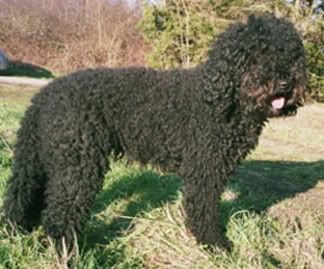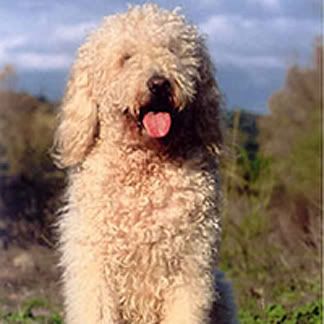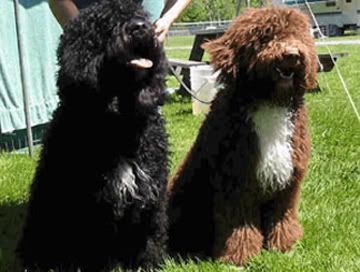Post by charmingnancy on Feb 16, 2009 11:51:47 GMT -5
Barbet
Group: 1- Sporting
Origin: France
Purpose: Water Dog

Description:
The Barbet, also known as the French Waterdog, is an ancient French breed who is ancestor to many of the breeds recognized around the world today, including the Poodle. Of medium-size, the Barbet has a distinctive thick, wooly coat along with a beard which gave the breed his name ("barbe" is french for "beard").
Appearance- Breed Standards:
Coat & Colour:
Skin: thick.
Coat: long, woolly and curly, forming cords. The coat is profuse and, in its natural state, covers the entire body. That is a particular breed characteristic. Since time immemorial, the barbet has been clipped in order to ease his work and lifestyle. According to how he is used, the barbet can present different appearances.
Colour: solid black, grey, chestnut brown, red fawn, sandy, white or pied. All shades from red fawn to sandy are permitted. Preferably the whole body should be in even shade.
Head: The coat on the head must fall to the bridge of the nose. The beard is long and ample; the profuse moustache covers the whole muzzle. Skull: round and broad. Stop: pronounced. Muzzle: quite square. The bridge of nose is broad and short. Lips: thick, pigmented, completely covered by long hair. The pigmentation of the mucous membranes may be black or brown. Eyes: round, preferably dark brown. Ears: set on low (in line with eyes or slightly lower), long, flat, broad, covered by long hair which
forms cords. If the ears are held together across the noseleather, they reach (with the hair) at least 5 cm beyond it. The ear cartilage reaches beyond the corner of the mouth.
Neck: Short and strong
Forequarters: Shoulders: sloping. The scapulo-humeral angle varies from 110 to 115°. Upper arm: strong and muscular. Lower arm: straight, strong, perpendicular, completely covered by long hair. Strong bone structure.
Body: Back: very slightly convex. Loin: arched, short and strong. Croup: rounded in profile. Chest: broad, developed, quite deep, rounded ribcage.
Hindquarters: Upper thigh: slight slope, well muscled. Hocks: set low. Well angulated. Metatarsus: well upright. Feet: round, broad, covered with hair.
Tail: Somewhat raised, yet not above a horizontal line. Set on low, forming a slight hook at the end.
Faults: Any departure from the foregoing points should be considered a fault and the seriousness with which the fault should be regarded should be in exact proportion to its degree.
• Head fine and narrow; bridge of nose thin and long; lips thin.
• Light eyes.
• Ears high set (higher than eye level), thin, short and narrow.
• Neck long and thin
• Top line hollow.
• Loin long and weak.
• Croup straight.
• Chest narrow.
• Tail high set on, curled over back.
• Lack of tail; stumpy tail.
• Shoulders upright.
• Upper arm thin.
• Lower arm fine boned. Forelegs fringed.
• Upper thigh flat; hocks straight; hindlegs fringed. Dewclaws.
• Feet thin and narrow, lacking hair.
• Skin thin.
• Coat short, harsh, not woolly, not curly.
• All colours other than those mentioned in the standard. Coat with
markings (parti or tricolour), black overlay, brindle, spotted, mottled.
Solid colour not in even shade.
Size:
Dogs 22 inches (58 cm) and Bitches 20 inches (53 cm) (minimum height at withers). Weight: 17-28 kg (35-60 pounds).

Hypoallergenic Claims: The Barbet coat is said to be hypoallergenic meaning Barbets, like poodles, do not have the same dander and shedding issues as other dogs. Their coats grow long and must be groomed regularly, otherwise the barbet may lose small tufts of hair like tumbleweeds.
Temperament:
The Barbet’s personality is described as companionable, joyful, goofy, obedient, and intelligent. They are quick to learn and need obedience training. They are a great with children, families, and the elderly.
Health:
Being a larger breed, some may develop hip dysplasia.
Average Lifespan:
The Barbet can live as long as 15 years with relatively few genetic health concerns.

History:
The Barbet breed is an integral part of dog history, and many familiar breeds have Barbet in their ancestry. Depending on geography and necessity, the Barbet connected through the centuries in various capacities, and as a companion dog.
The Barbet is thought to be the original source of the various water dog breeds (Poodle, Portuguese Water Dog, American Water Spaniel, and so on). Its actual origin is lost in antiquity but probably stems from corded herding stock and perhaps griffon hounds (griffons are dogs with hair over their eyes). The breed is gaining popularity in Scandinavian countries and North America as more and more people are becoming interested in this all-around working dog or just as a pet.
It has been said that the French Royals have been hunting with Barbet for all time. The Barbet has also worked as sailor’s assistants, much like the Portuguese Water Dog.
The versatile nature of the Barbet has meant its survival, and today's Barbet still has the assets attributed to it from the past.
There are very few Barbet in the United States. Estimated as of 2009 are less than 47 known Barbet. Steps are being taken to slowly increase Barbet in the States. Currently, Barbets may be fully registered in the United States with ARBA or the UKC, and there has been a recent acceptance in the AKC Foundation Stock Service Program. According to the AKC, to get full recognition there needs to be at least 300 Barbet to apply. So, every Barbet registered with the AKC FSS program is helping the Barbet get to that goal.
Sources:
Wikipedia
Canada's Guide to Dogs
CKC
Dogster
Pictures:
Photobucket
Group: 1- Sporting
Origin: France
Purpose: Water Dog

Description:
The Barbet, also known as the French Waterdog, is an ancient French breed who is ancestor to many of the breeds recognized around the world today, including the Poodle. Of medium-size, the Barbet has a distinctive thick, wooly coat along with a beard which gave the breed his name ("barbe" is french for "beard").
Appearance- Breed Standards:
Coat & Colour:
Skin: thick.
Coat: long, woolly and curly, forming cords. The coat is profuse and, in its natural state, covers the entire body. That is a particular breed characteristic. Since time immemorial, the barbet has been clipped in order to ease his work and lifestyle. According to how he is used, the barbet can present different appearances.
Colour: solid black, grey, chestnut brown, red fawn, sandy, white or pied. All shades from red fawn to sandy are permitted. Preferably the whole body should be in even shade.
Head: The coat on the head must fall to the bridge of the nose. The beard is long and ample; the profuse moustache covers the whole muzzle. Skull: round and broad. Stop: pronounced. Muzzle: quite square. The bridge of nose is broad and short. Lips: thick, pigmented, completely covered by long hair. The pigmentation of the mucous membranes may be black or brown. Eyes: round, preferably dark brown. Ears: set on low (in line with eyes or slightly lower), long, flat, broad, covered by long hair which
forms cords. If the ears are held together across the noseleather, they reach (with the hair) at least 5 cm beyond it. The ear cartilage reaches beyond the corner of the mouth.
Neck: Short and strong
Forequarters: Shoulders: sloping. The scapulo-humeral angle varies from 110 to 115°. Upper arm: strong and muscular. Lower arm: straight, strong, perpendicular, completely covered by long hair. Strong bone structure.
Body: Back: very slightly convex. Loin: arched, short and strong. Croup: rounded in profile. Chest: broad, developed, quite deep, rounded ribcage.
Hindquarters: Upper thigh: slight slope, well muscled. Hocks: set low. Well angulated. Metatarsus: well upright. Feet: round, broad, covered with hair.
Tail: Somewhat raised, yet not above a horizontal line. Set on low, forming a slight hook at the end.
Faults: Any departure from the foregoing points should be considered a fault and the seriousness with which the fault should be regarded should be in exact proportion to its degree.
• Head fine and narrow; bridge of nose thin and long; lips thin.
• Light eyes.
• Ears high set (higher than eye level), thin, short and narrow.
• Neck long and thin
• Top line hollow.
• Loin long and weak.
• Croup straight.
• Chest narrow.
• Tail high set on, curled over back.
• Lack of tail; stumpy tail.
• Shoulders upright.
• Upper arm thin.
• Lower arm fine boned. Forelegs fringed.
• Upper thigh flat; hocks straight; hindlegs fringed. Dewclaws.
• Feet thin and narrow, lacking hair.
• Skin thin.
• Coat short, harsh, not woolly, not curly.
• All colours other than those mentioned in the standard. Coat with
markings (parti or tricolour), black overlay, brindle, spotted, mottled.
Solid colour not in even shade.
Size:
Dogs 22 inches (58 cm) and Bitches 20 inches (53 cm) (minimum height at withers). Weight: 17-28 kg (35-60 pounds).

Hypoallergenic Claims: The Barbet coat is said to be hypoallergenic meaning Barbets, like poodles, do not have the same dander and shedding issues as other dogs. Their coats grow long and must be groomed regularly, otherwise the barbet may lose small tufts of hair like tumbleweeds.
Temperament:
The Barbet’s personality is described as companionable, joyful, goofy, obedient, and intelligent. They are quick to learn and need obedience training. They are a great with children, families, and the elderly.
Health:
Being a larger breed, some may develop hip dysplasia.
Average Lifespan:
The Barbet can live as long as 15 years with relatively few genetic health concerns.

History:
The Barbet breed is an integral part of dog history, and many familiar breeds have Barbet in their ancestry. Depending on geography and necessity, the Barbet connected through the centuries in various capacities, and as a companion dog.
The Barbet is thought to be the original source of the various water dog breeds (Poodle, Portuguese Water Dog, American Water Spaniel, and so on). Its actual origin is lost in antiquity but probably stems from corded herding stock and perhaps griffon hounds (griffons are dogs with hair over their eyes). The breed is gaining popularity in Scandinavian countries and North America as more and more people are becoming interested in this all-around working dog or just as a pet.
It has been said that the French Royals have been hunting with Barbet for all time. The Barbet has also worked as sailor’s assistants, much like the Portuguese Water Dog.
The versatile nature of the Barbet has meant its survival, and today's Barbet still has the assets attributed to it from the past.
There are very few Barbet in the United States. Estimated as of 2009 are less than 47 known Barbet. Steps are being taken to slowly increase Barbet in the States. Currently, Barbets may be fully registered in the United States with ARBA or the UKC, and there has been a recent acceptance in the AKC Foundation Stock Service Program. According to the AKC, to get full recognition there needs to be at least 300 Barbet to apply. So, every Barbet registered with the AKC FSS program is helping the Barbet get to that goal.
Sources:
Wikipedia
Canada's Guide to Dogs
CKC
Dogster
Pictures:
Photobucket

